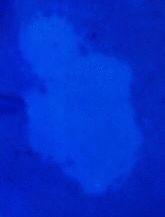The Wood’s Lamp – invented in 1903 by Baltimore physicist Robert W Wood – is a source of long wave ultraviolet light used as a diagnostic aid for various dermatological conditions, including vitiligo and skin cancer. A recently published review from Aboud and Gossman (2020) has outlined the significance of the Wood’s Lamp in contemporary dermatology.

Long wave ultraviolet light emitted by the Wood’s Lamp detects fluorescence in skin and hair. Unaffected skin will appear violet under the light of the Wood’s Lamp. However, a colour change is seen under the light where pigmentary changes exist (see image). The modern version of the Wood’s Lamp uses a wavelength of 395 nm and is used also used in detecting skin cancers (such as basal cell carcinoma) and pre-cancerous tumours, actinic keratosis.
Aboud and Gossman (2020) highlight that a Wood’s Lamp test may not always be suitable if, for instance, results are ambiguous, making it difficult to interpret. They note that external light interference, make up, skin products, and other small particles can interfere with interpretation of results, requiring careful examination by dermatologists.
To read more about pigmentary skin conditions, visit our vitiligo webpage. Or, for further reading on UV and pigmentation, read our Technology Update 1: original thoughts on UV and pigmentation.
